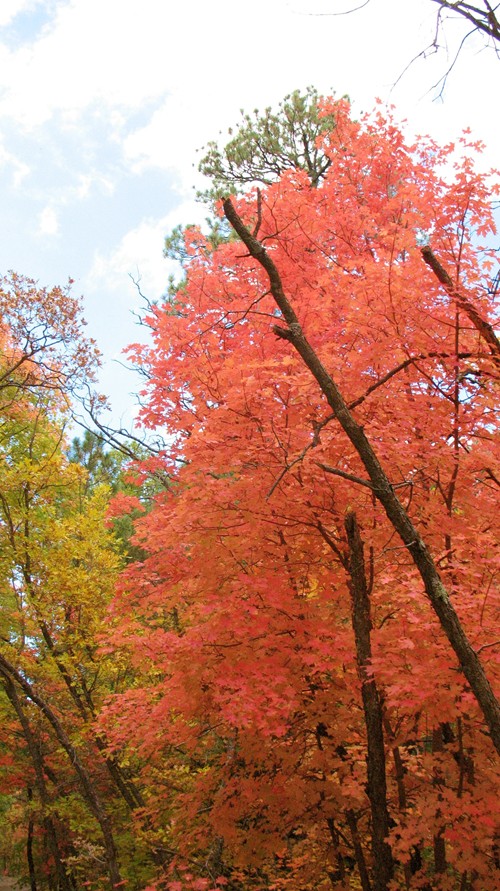Fourth of July in October
by wjw on October 19, 2010

I don’t know why we haven’t done this before, since the place is so close, but today we went to Fourth of July Canyon to see the autumn maples.
New Mexico mountains were covered with maples during the last Ice Age, but as the continent warmed, the maples were gradually replaced with the pine and aspen that we see now. There are no more maples in New Mexico, except for one canyon where the microclimate remains ideal.
The first of October is usually the time when you’ll want to go, but this year’s summer was so hot and so persistent that when we visited ten days ago, the maples had only started to turn. Now many of the maples are blazing, though the majority of them are still green. Go now if you’re going, because after the first frost, all the leaves are going to turn brown and drop.
So I hiked up and down for over an hour, taking a great many pictures, but it turns out that the best views are within five minutes of the camp site. It’s an ideal setup for lazy people!
Nearby is the old Spanish village of Manzano, which gave its name to the entire mountain range near which it sits. (Manzano is Spanish for “apple.”) When the first Spanish settlers came into the area, they settled near an old apple orchard, and named the village after it.
But the apple is an Old World fruit. Who was in the New Mexico mountains planting an apple orchard many scores of years before the first Spanish arrived?
Juanito Appleseed, perhaps?
Glorious picture, Walter! I was intrigued by the idea of a single canyon containing a relict population of New Mexican maples. I’ve seen similar places in the Rhodope Mountains of Bulgaria where plants, which should be extinct, still cling to the sides of steep gorges.
On the subject of apples: although the common ‘domestic’ apple (Malus domestica – not surprisingly!) is of Eurasian origin (I believe the ancestral species originated in Khazakstan) there are members of the genus Malus in the North American flora. My copy of Britton and Brown lists 15 species for the Northern US and Canada. I don’t know if there are any members of the genus native to New Mexico – because I don’t have a New Mexican flora – but I wouldn’t be surprised. What’s really interesting is the idea that local Native Americans might have domesticated them (although didn’t the Navajo have peach orchards?).
How very New England of you. After moving away from New England I used to have vivid dreams in the fall of these colors.
Oz
Little biological ‘islands’ like that always fascinate me. Here in western NC we’ve got the Black Mountains, a range with peaks like Mount Mitchell reaching almost 7000 feet, the highest east of the Mississippi. The flora and fauna up there are, for all practical purposes, Canadian. Nothing else like it in the southeast. A little island, left behind when the glaciers receded and everything else in the area warmed up and changed. One of my favorite places, if only because I love watching everything change as you ascend.
Dave, I’ve heard two conflicting story on Navajo peaches.
The first is that the peach trees weren’t what Europeans would recognize as peaches, but some native species.
And the second is that the Navajo learned peach farming from the Hopi, who themselves learned it from the Spanish.
Yes, I became intrigued by all this, and tried to do a bit of research, and came up against the same conflict. Perhaps Native Americans, in the South West at least, had fruit growing traditions which have never been adequately researched – perhaps everyone has just assumed that they learned fruit growing from the Spanish (?)
If the Hopi learned fruit growing from the Spanish, it must have been from the very few missionaries that were in that area. The Spanish never “conquered” the Hopi as such, and never had a military garrison in the area, but they did convert a substantial minority to Christianity.
A small correction: “manzano” is Spanish for apple *tree*. “Manzana” is apple.
Great pic and thanks for the info on why maples only here.
Lovely photo.. Just one thing. Manzano is Spanish for apple orchard. Manzana is the word for apple. Enjoy this fall.
Manzano means “apple tree”. Manzana means “apple”.
Sorry, I can’t agree with, “There are no more maples in New Mexico, except for one canyon where the microclimate remains ideal.”
There is at least one other canyon, in the Organ Mountains outside Las Cruces where relict bigtooth maples dwell. I keep looking for more.
Sincerely, Richard (Mike) Tuggle
Comments on this entry are closed.